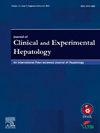血清白细胞介素-6水平可能是肝硬化和急性静脉曲张出血患者6周进一步失代偿风险的关键决定因素:一项概念验证研究
IF 3.3
Q2 GASTROENTEROLOGY & HEPATOLOGY
Journal of Clinical and Experimental Hepatology
Pub Date : 2025-01-02
DOI:10.1016/j.jceh.2024.102496
引用次数: 0
摘要
背景和目的关于全身性炎症和肠道屏障功能障碍在急性静脉曲张出血(AVB)中的作用的数据有限。我们研究了AVB患者的炎症标志物和肠屏障的变化,并评估了这些是否可以用于识别与结果相关的高风险亚组。方法在这项前瞻性观察研究中,在三级保健中心就诊的肝硬化和AVB患者在6周的随访中是否发生急性代偿失代偿(AD)进行分层。通过免疫组化(IHC)评估全身炎症标志物(白细胞介素-6 [IL-6]、c反应蛋白)、内毒素血症(血清IgM/IgG抗内毒素抗体)和十二指肠上皮紧密连接蛋白(TJPs)对紧密连接蛋白(cludin -2、-4、封闭带-1(ZO-1)、连接粘附分子(JAM))的应用,以预测预后。将这些参数与先前存在的肝硬化且近期无静脉曲张出血的患者和无肝硬化(消化不良且无内窥镜病理)的患者进行比较。从多变量模型中开发了一种nomogram来预测AVB患者6周AD。结果AVB患者66例(年龄:46.4±11.7岁;病因:包括酒精/NASH/HBV/HCV[48.5%/12.1%/12.1%/7.6%])。24例(36.3%)患者发展为6周AD。6周AD患者血清IL-6较高(中位数:156.14 pg/ml [IQR: 136.12-170.52] vs 58.28 pg/ml [31.70-110.67];P & lt;0.001)和儿童评分(中位数:9 [6.75-10.25]vs 7 [6-9];P = 0.042)。血清内毒素血症和十二指肠上皮TJP相似。生成CTP和IL-6联合的nomogram,预测6周AD,乐观校正的c统计量为0.87。非出血性肝硬化(n = 52)(7.57[5.48-9.87])与消化不良对照组(n = 53)(5.72[4.40-6.45])的比较;P & lt;0.001)也发现血清IL-6显著升高,不能完全用TJP和细菌易位标记物的紊乱来解释。结论Child评分和血清IL-6可联合预测肝硬化合并AVB患者6周AD发生率。本文章由计算机程序翻译,如有差异,请以英文原文为准。

Serum Interleukin-6 Levels may be a Key Determinant of 6-week Further Decompensation Risk in Patients With Cirrhosis and Acute Variceal Bleed: A Proof of Concept Study
Background and aims
Limited data exist on the role of systemic inflammation and gut barrier dysfunction in acute variceal bleed (AVB). We studied inflammatory markers and changes in the intestinal barrier in patients with AVB and assessed if these can be used to identify a higher risk subgroup with regard to outcomes.
Methods
In this prospective observational study, patients with cirrhosis and AVB presenting at a tertiary care center were stratified by whether or not they developed acute decompensation (AD) over 6 weeks follow-up. Utility of systemic inflammatory markers (interleukin-6 [IL-6], C-reactive protein), endotoxinemia (serum IgM/IgG anti-endotoxin antibodies), and duodenal epithelial tight junction proteins (TJPs) by immunohistochemistry (IHC) for tight-junction proteins (claudin-2,-4, zonula occludens-1(ZO-1), junctional adhesion molecule (JAM)) was assessed to predict the outcomes. These parameters were compared with a pre-existing cohort of patients with cirrhosis and no recent variceal bleed and with those without cirrhosis (dyspepsia with no endoscopic pathology). A nomogram was developed from multivariate model to predict 6-wk AD in patients with AVB.
Results
Patients with AVB(n = 66) (age:46.4 ± 11.7 years; etiology: alcohol/NASH/HBV/HCV [48.5%/12.1%/12.1%/7.6%]) were included. Twenty-four (36.3%) patients developed 6-wk AD. Patients with 6-wk AD had higher serum IL-6 (median: 156.14 pg/ml [IQR: 136.12–170.52] vs 58.28 pg/ml [31.70–110.67]; P < 0.001) and Child score (median: 9 [6.75–10.25] vs 7 [6–9]; P = 0.042) at baseline. Serum endotoxinemia and duodenal epithelial TJP were similar. A nomogram combining CTP and IL-6 was generated that predicted 6-wk AD with optimism-corrected c-statistic of 0.87. Comparison with non-bleeder cirrhosis (n = 52) (7.57 [5.48–9.87]) and dyspepsia controls (n = 53) (5.72 [4.40–6.45]; P < 0.001) also identified significant elevation of serum IL-6, not entirely explainable by derangements in TJP and bacterial translocation markers.
Conclusion
6-wk AD rates in patients with cirrhosis and AVB can be predicted using combination of Child score and serum IL-6.
求助全文
通过发布文献求助,成功后即可免费获取论文全文。
去求助
来源期刊

Journal of Clinical and Experimental Hepatology
GASTROENTEROLOGY & HEPATOLOGY-
CiteScore
4.90
自引率
16.70%
发文量
537
审稿时长
64 days
 求助内容:
求助内容: 应助结果提醒方式:
应助结果提醒方式:


